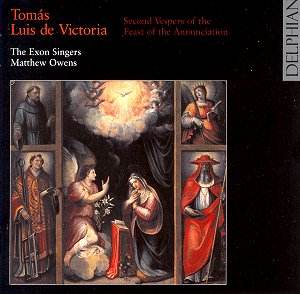Of all composers of the Spanish
renaissance Victoria is the most frequently performed and recorded.
In particular his Tenebrae Responsories and his Requiem have
received much attention. A large proportion of his music is
related to the devotion of the Virgin Mary, which is reflected
by the many recordings of his Marian motets. This disc presents
a collection of music for use at the Second Vespers of the Feast
of the Annunciation. Most of the music has probably been written
during De Victoria's stay in Rome. In the booklet the musicologist
Jon Dixon, who put together this programme, writes: "There
is no direct evidence that the continuous use of polyphony on
this scale in Vespers was practised in late sixteenth century
Rome, or that the early seventeenth century Venetian practice
of replacing antiphons with motets on similar texts was followed
in Rome at Victoria's time." But: "This project examines
some of the Marian music Victoria wrote, with consideration
to the liturgical context in which it might have been used."
I find this project rather questionable.
The programme is not presented as "an 'authentic' reconstruction,
but more as a musical offering demonstrating how this wonderful
body of music could be performed employing some of the liturgical
practices that developed in the following generation".
From the use of the words 'could be' (rather than 'could have
been') one has to conclude that there is no historical foundation
whatsoever for the way this music is used here. But if there
is no shred of evidence that De Victoria's Marian motets could
ever have been used to replace plainchant in a Vesper service,
for instance, then what is the point of presenting them this
way?
The Exon Singers are one of the
leading British chamber choirs, which was founded in 1966. Although
its repertoire ranges from the renaissance to the present day,
the core of its activities is the music of the 20th century,
as the concert programmes and the discography on its website
shows. Here it consists of 8 sopranos, 5 altos (male and female),
5 tenors and 6 basses. There is no doubt this is a very fine
choir, which produces a strong sound. In particular the Vesper
Psalms get a bright and vibrant interpretation which underlines
their jubilant character.
But the performance also lacks
some subtlety and differentiation, in particular in regard to
dynamics and articulation. Even though classical polyphony has
to be sung basically legato, not every line should be sung in
one breath, without any stressing of words or syllables. And
here too much is sung at the same dynamic level, mostly forte,
which becomes pretty tiring after a while. A more relaxed and
flexible approach would have done this recording a lot of good.
It is especially in the more intimate
pieces where this performance fails to convey the character
of the music. The interpretation of the strongly emotional 8-part
Ave Maria, for instance, is much too down-to-earth. The recording
by Pro Cantione Antiqua ('El Siglo de Oro', Teldec) brings out
with greater strength the exaltation of this motet. The last
piece on this disc, the litany Kyrie eleison, in which the Virgin
Mary - referred to with many different names (Holy Mother, Holy
Virgin, Virgin of virgins, Queen of the Angels, Queen of the
Martyrs etc) - is asked to pray for the sinners, is too straightforward.
I would recommend this recording
in particular because of the four Vesper Psalms, which show
a somewhat different side of De Victoria's art and which have
not to date been paid enough attention. But the liturgical context
is without historical foundation, and some of the other items
lack the necessary emotional power.
Johan van Veen
see also Review
by John Quinn

![]() The Exon Singers/Matthew
Owens
The Exon Singers/Matthew
Owens![]() DELPHIAN DCD 34025 [68:46]
DELPHIAN DCD 34025 [68:46]





